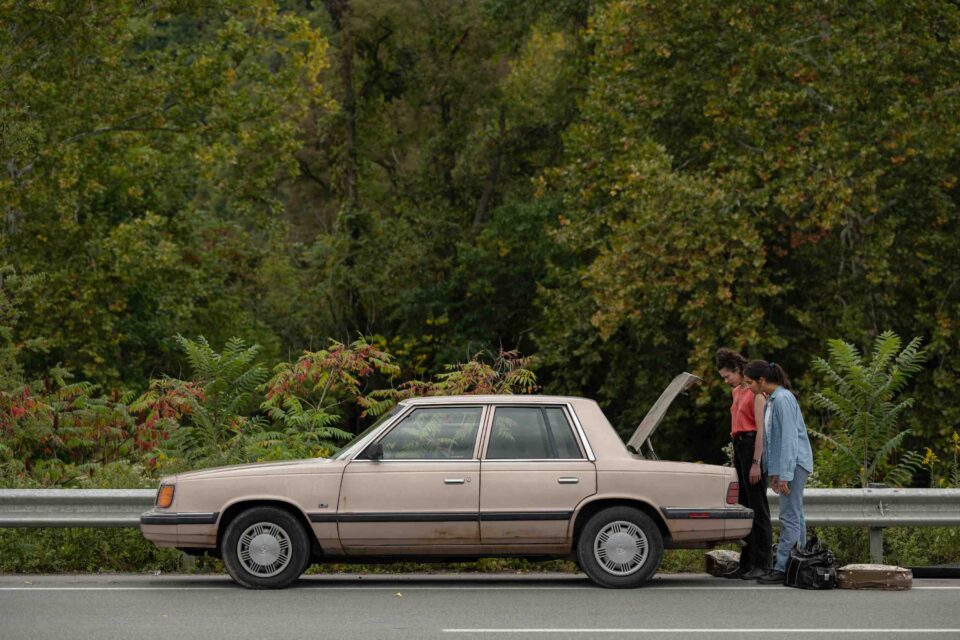About 20 years ago, Ethan Coen wrote a script with his wife, Tricia Cooke. Originally titled “Drive-Away Dykes,” the film had momentum around 2007, only to be shelved for the last 15 years. Released with the new title of Drive-Away Dolls, Ethan’s first solo narrative directorial effort finds the younger Coen brother working with a lighter tone. A queer roadtrip romp, the comedy grabs inspiration from the past five decades of romance exploitation films. It uses flashy names in small parts, psychedelic interludes featuring Miley Cyrus, and a slapdash style of screen wipes, tilts, and progressive sound effects usually reserved for middle school PowerPoints.
Margaret Qualley and Geraldine Viswanathan star as Jamie and Marian, two friends headed to Tallahassee in a vehicle with some stolen, precious cargo unwittingly in the trunk. Qualley fills up the screen as Jamie, putting on a strong Southern accent and flying through the script. She’s doing capital-A acting, hamming it up to bring consistent energy to Coen’s vision. Viswanathan attempts to be her foil, existing inside a monotone, structured character. Each of these leads rarely veer from their given paths, becoming one-note despite the speedy runtime of 84 minutes and the constant hijinks of those following them on the road trip.
The film is sure to earn comparisons to early Coen brothers’ works like Raising Arizona and The Hudsucker Proxy in its tone and execution. But Drive-Away Dolls sees Ethan Coen experimenting without the success audiences have come to expect from someone with his last name. The psychedelic pauses tire more than they excite, and the inclusion of these scenes feels forced rather than fun. His flourishes put unnecessary emphasis on the film’s intentional camp instead of letting the screenplay and the performances do the majority of the heavy lifting.
The comedy works in spurts, and the script remains unabashedly, proudly queer. Sex often comes without fanfare or lead-up in this film, existing as a part of the day-to-day for these lesbian friends and their surrounding community, an obvious aspect of life that often goes ignored, tempered, or simply erased in Hollywood filmmaking. It’s fun, less filtered directing from Coen and a reason to join this trip despite other, more unnecessary elements.

(L to R) Margaret Qualley as “Jamie” and Geraldine Viswanathan as “Marian” in director Ethan Coen’s DRIVE-AWAY DOLLS, a Focus Features release. Credit: Wilson Webb / Working Title / Focus Features
Drive-Away Dolls discovers the majority of its laughs in Jamie and Marian’s interactions with the rest of the cast. As their world expands, the film brings in a stream of plug-and-play supporting actors. Bill Camp pops in as Curlie, the owner of the rental car shop, hilarious with every line reading. Beanie Feldstein begins and ends the movie with a jolt of energy and fun as Marian’s ex-girlfriend. Even Matt Damon shows up for five minutes to steal a later scene. The cast dances along to the script’s offbeat tune and the audience should clap for each of their additions.
The MVPs of the minor players come through the performances of Joey Slotnick as Arliss and C. J. Wilson as Flint, the two goons chasing the girls. Their interplay provides respite from the breakneck speed of the action, and they work well with Qualley and Viswanathan in limited screen time. Slotnick specifically puts on a spectacle of droll humor. He’s perfect with Coen and Cooke’s script.
Drive-Away Dolls is an homage to the films of Coen and Cooke’s adolescent years, but its quirks don’t equate to prolonged success. It’s a jagged film, one with heart and verve, but lacking reliability and steadiness. It’s a fun effort that will connect with some and leave others jumbled. To be fair, I laughed often during Coen’s first solo narrative feature, though it became tough to understand whether I was laughing at the absurdity of the film or at the absurdity of the choices being made.







